|
|
| Home - Software M&A Review |
Software M&A - Q2 Review
continued... page 3 |
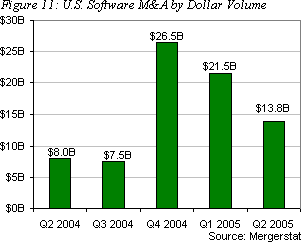 Exit valuations increased modestly in 2Q05, and are currently slightly above historical norms. The median software company M&A valuation (based on equity purchase price) reached 2.4 times trailing-twelve-months (TTM) revenue in 2Q05, a 14.3% increase from the median M&A valuation of 2.1x in 1Q05 (Figure 12). Exit valuations increased modestly in 2Q05, and are currently slightly above historical norms. The median software company M&A valuation (based on equity purchase price) reached 2.4 times trailing-twelve-months (TTM) revenue in 2Q05, a 14.3% increase from the median M&A valuation of 2.1x in 1Q05 (Figure 12).
Deal consideration in 2Q05 strongly favored cash over stock, reflecting sellers" growing uneasiness with an erratic stock market and buyers" burgeoning cash reserves. 67% of buyers in 2Q05 used cash - up from 61% in 1Q05. Only 8% of buyers in 2Q05 paid all stock (vs. 17% in 1Q05) and 25% used a combination of cash and stock (vs. 22% in 1Q05) (Figure 13).
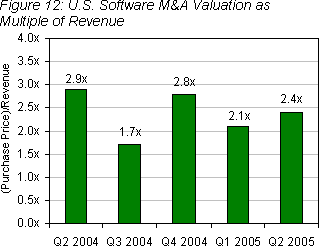 Private software companies continued to comprise the vast majority of sellers in 2Q05. Of the 170 deals we analyzed, 93% of acquired companies were private and 7% were public, a percentage consistent with 2004. However, public buyers constituted a higher percentage (71%) than in prior quarters, reflecting a retreat by private equity firms and VC-backed private software company buyers (Figure 14 and 15). Private software companies continued to comprise the vast majority of sellers in 2Q05. Of the 170 deals we analyzed, 93% of acquired companies were private and 7% were public, a percentage consistent with 2004. However, public buyers constituted a higher percentage (71%) than in prior quarters, reflecting a retreat by private equity firms and VC-backed private software company buyers (Figure 14 and 15).
Buyers are showing a distinct bias for top line growth, with larger sell-side public software companies commanding higher valuations compared to their smaller peers. Over the last twelve months, the median revenue multiple (equity value) for acquired public companies with more than $100 million in revenue was 3.2x, but only 2.0x for acquired public companies with revenue less than $100 million. The median revenue multiple for acquired public companies with revenue between $50 million and $100 million was 3.6x, presumably because many in this category offered buyers both strategic leverage and substantial revenue growth.
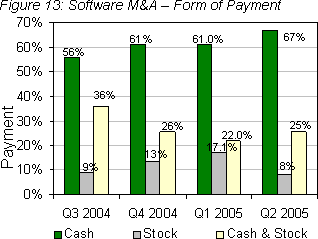 Surprisingly, the same pattern did not hold true for the private market. The median revenue multiple for privately held sellers with revenue greater than $100 million was 0.9x, compared to 2.4x for companies with revenue less than $100 million. There was no significant variation in median valuation for private sellers with revenue between $0 and $25 million as compared to those with revenue between $25 million and $100 million. Surprisingly, the same pattern did not hold true for the private market. The median revenue multiple for privately held sellers with revenue greater than $100 million was 0.9x, compared to 2.4x for companies with revenue less than $100 million. There was no significant variation in median valuation for private sellers with revenue between $0 and $25 million as compared to those with revenue between $25 million and $100 million.
Mergers and Acquisitions: Buyer Motives
Product Extension
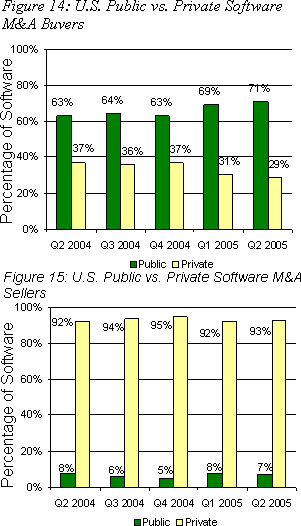 A deal-by-deal analysis of 170 second quarter software transactions we analyzed reveals 49% of the buyers sought to enhance their current product suite by acquiring small and mid-cap companies targeting the same markets with highly complementary, best-of-breed, market proven products and technology (Figure 16). Their objective was to better satisfy market requirements and thereby differentiate from the competition and create new sources of revenue. The sellers that provided this product extension leverage commanded the highest multiple in 2Q05 (3.1x) compared with other buyer motive categories. Examples include Citrix Systems acquisition of NetScaler to expand its platform and enter into the high growth network acceleration market; Trend Micro's entry into the frenzied security software M&A realm by acquiring anti-spyware (InterMute) and anti-spam (Kelkea); and Computer Associates" acquisition of Niku to add a best of breed IT governance and compliance automation solution to its solution suite. A deal-by-deal analysis of 170 second quarter software transactions we analyzed reveals 49% of the buyers sought to enhance their current product suite by acquiring small and mid-cap companies targeting the same markets with highly complementary, best-of-breed, market proven products and technology (Figure 16). Their objective was to better satisfy market requirements and thereby differentiate from the competition and create new sources of revenue. The sellers that provided this product extension leverage commanded the highest multiple in 2Q05 (3.1x) compared with other buyer motive categories. Examples include Citrix Systems acquisition of NetScaler to expand its platform and enter into the high growth network acceleration market; Trend Micro's entry into the frenzied security software M&A realm by acquiring anti-spyware (InterMute) and anti-spam (Kelkea); and Computer Associates" acquisition of Niku to add a best of breed IT governance and compliance automation solution to its solution suite.
Market Expansion
22% of buyers (vs. 16% in 1Q05) ventured further from home, acquiring software companies in new product categories and new geographic and vertical markets in an effort to accelerate growth. New market buyers included Captiva, provider of content and document management, which acquired SWT SA, a document management provider and long time partner to expand its geographic coverage in France and Spain. Clark Consulting, a large provider of benefits and compensation consulting, acquired BancPlan, developer of software targeting the banking vertical. Alien Technology, a leader in RFID technology, acquired Quatrotec, a project management firm focusing on the transportation vertical. Speech recognition software developer Scansoft, acquired MedRemote to gain access to the healthcare vertical. Market expansion deals had a median valuation multiple of 1.7x in 2Q05, a slight increase to the 1.3x observed for this category last quarter.
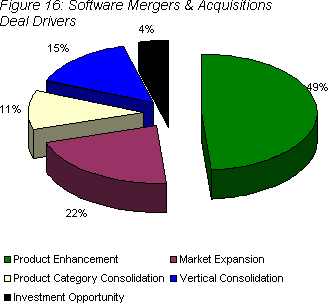 Vertical Markets Vertical Markets
Vertical market software company acquisitions comprised about 15% of M&A transactions in 2Q05 compared to 12% in 1Q05. Vertical market buyers paid a median 2.1x TTM multiple, mostly for products and enabling technology that would extend their suites and provide competitive differentiation. Healthcare was the most active software M&A vertical market, although 2Q05 saw a significant increase in financial sector deals. Aetna, one of the nation's largest health insurance companies, paid an estimated 10x for ActiveHealth Management, a developer of health care data analytics. SS&C continued to acquire software companies serving the financial sector. This time it was Financial Interactive, a solution provider to hedge funds. Retalix, feeling the heat after its competitor Retek was acquired by Oracle, acquired two software providers (TCI and Integrated Distribution Solutions) to strengthen its retail vertical expertise.
...more...

|
|


|

